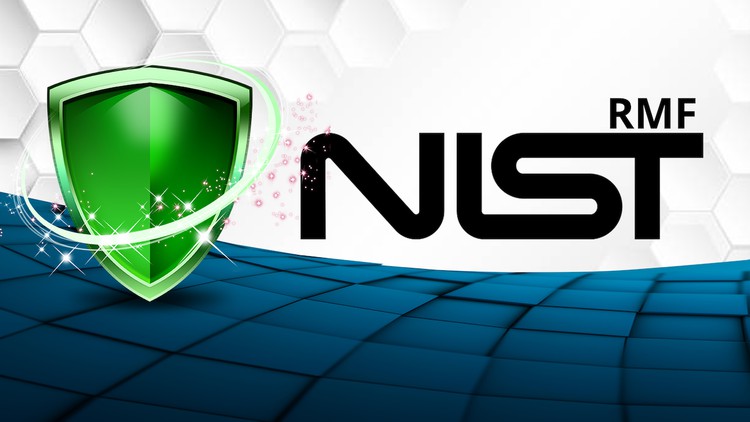NIST Cybersecurity A-Z: NIST Risk Management Framework (RMF)
- Description
- Curriculum
- FAQ
- Reviews
The NIST Risk Management Framework (RMF) provides a comprehensive, flexible, repeatable, and measurable 7-step process that any organization can use to manage information security and privacy risk for organizations and systems and links to a suite of NIST standards and guidelines to support implementation of risk management programs to meet the requirements of the Federal Information Security Modernization Act (FISMA).
-
Prepare essential activities to prepare the organization to manage security and privacy risks
-
Categorize the system and information processed, stored, and transmitted based on an impact analysis
-
Select the set of NIST SP 800-53 controls to protect the system based on risk assessment(s)
-
Implement the controls and document how controls are deployed
-
Assess to determine if the controls are in place, operating as intended, and producing the desired results
-
Authorize senior official makes a risk-based decision to authorize the system (to operate)
-
Continuously monitor control implementation and risks to the system
This course will give you comprehensive understanding of the risk management process for all organizations. Therefore, the NIST RMF is also potentially applicable to risk management in all corporate settings. This course is a comprehensive explication of the topic of risk management and it will allow a person to understand the application and uses of the RMF content. The people who would benefit from this knowledge range from managers to all types of technical workers and specialists.
Section 2: Introduction to Organizational Security Risk Management
This section presents an overview of organizational risk management through an exploration of the types of organizational risks that senior leaders must identify, the necessity and benefits of managing those risks, and the information security regulation that senior leaders must consider as they manage risk.
Section 3: Survey of Existing Risk Management Models
This section discuss various models that can be used to implement the NIST RMF. The goal is to provide a comparative assessment of existing models and demonstrate how the NIST framework sets itself apart from other models.
Section 4: Categorize Information and Information Systems
This section begins with a definition of security impact analysis. CNSSI 1253 Security Categorization and Control Selection for National Security Systems and FIPS 199 Standards for Security Categorization of Federal Information and Information Systems are explored, compared, and contrasted as a source of guidelines for organizations to perform the information system categorization process. The major focus of this section centers around understanding the tables available in NIST SP 800- 60, Guide for Mapping Types of Information and Information Systems; the security categories; and utilizing FIPS 199 as a means of implementing the security categorization; and the information classification process of the NIST RMF.
Section 5: Select Security Controls
This section begins with an introduction of FIPS 200, Minimum Security Requirements for Federal Information and Information Systems. Further, this guideline is used for establishing security boundaries and the identification of minimum security requirements. This section also provides a discussion related to the contents of the security plan, and continuous monitoring strategy (which are two of the underlying outputs of the control selection process).
Section 6: Implement Security Controls
This section starts with a review of the system development life cycle (SDLC) and explores when activities and tasks associated with security control implementation get performed. Emphasis is placed on the standards development and acquisition processes as a means for providing details related to the development of an organizational information security architecture while at the same time integrating it into the organization’s enterprise architecture.
Section 7: Assess Security Controls
This section begins by using NIST 800-30, Guide for Conducting Risk Assessments, as a directive for a discussion of the process of security risk assessment. You will understand that security risk assessment and security control assessment are not only different processes but also complimentary in nature. The major focus of this section is on how to use NIST SP 800- 53A, Assessing Security and Privacy Controls in Federal Information Systems and Organizations—Building Effective Assessment Plans. This includes development of a security control assessment plan. The section will also demonstrate that through security control assessment based on an established plan, you will be able to identify and further disclose security risks that may exist within the organization.
Section 8: Authorize Information Systems
The first major component of this section provides a detailed discussion of the creation and dissemination of the security authorization package that includes: security plan, security assessment report, and plan of action and milestones. This section begins with a discussion of the criteria included and creation of a plan of action and milestones. You will appreciate that the plan provides the strategies for how the organization will correct security weaknesses or deficiencies identified through security control assessment.
Section 9: Monitor Security State
This section emphasizes the strategies associated with the ongoing security control assessments, remediation action strategies, procedures for implementing documentation and plan updates, implementing security status reporting procedures, strategies associated with ongoing risk determination and acceptance, and secure procedures for information system removal and decommission.
Section 10: Practical Application of the NIST RMF
This section provides specific examples of the implementation process for small-, medium-, and large-scale organizational applications. This is in the form of case studies that will be presented as model representations of the practical advantages and pitfalls of implementing the RMF as an end-to-end process. The aim of this final section is to give you a concrete understanding of the real-world issues associated with enterprise risk management, as well as to suggest pragmatic strategies for implementation of the RMF within a range of settings.
You are going the get the ultimate learning experience as every section is followed by practice test and has reading resources uploaded.
-
3Introduction to Organizational Security Risk ManagementVideo lesson
-
4Strategic Governance and Risk ManagementVideo lesson
-
5Risk Types and Risk Handling StrategiesVideo lesson
-
6Overview of the Risk Management ProcessVideo lesson
-
7Identifying and Categorizing the Risk EnvironmentVideo lesson
-
8Risk AssessmentVideo lesson
-
9Designing for Effective Risk ManagementVideo lesson
-
10Evaluating Candidates for ControlVideo lesson
-
11Implementing Risk Management ControlsVideo lesson
-
12Assessment and Effectiveness of Risk ControlsVideo lesson
-
13SustainmentVideo lesson
-
14Evaluation of the Risk Management FunctionVideo lesson
-
15Survey of Existing Risk Management FrameworksVideo lesson
-
16Making Risk Management TangibleVideo lesson
-
17Formal ArchitecturesVideo lesson
-
18General Shape of the RMF ProcessVideo lesson
-
19RMF ImplementationVideo lesson
-
20International Organization StandardsVideo lesson
-
21OSI 31000 Implementation ProcessVideo lesson
-
22COSO Enterprise Risk Management FrameworkVideo lesson
-
23Health Information Trust Alliance Common Security FrameworkVideo lesson
-
24Implementing the HITRUST CSF Control StructureVideo lesson
-
25NIST SP 800-30 and NIST SP 800-39 StandardsVideo lesson
-
26Step 1—Categorize Information and Information SystemsVideo lesson
-
27Security Impact AnalysisVideo lesson
-
28FIPS 199 StandardsVideo lesson
-
29FIPS 199 Standards of Information TypesVideo lesson
-
30CNSSI Security CategorizationVideo lesson
-
31Implementation of Step 1: Security CategorizationVideo lesson
-
32Security Categorization from the Organizational PerspectiveVideo lesson
-
33Establish Relationships with Organizational EntitiesVideo lesson
-
34Prepare an Organization-Wide Guidance ProgramVideo lesson
-
35Security Categorization from Management ProspectiveVideo lesson
-
36Preparing for System Security CategorizationVideo lesson
-
37System Security Categorization: Step 2, Step 3 and Step 4Video lesson
-
38Obtain Approval for the System Security Category and Impact LevelVideo lesson
-
39Step 2—Select Security ControlsVideo lesson
-
40Understanding Control SelectionVideo lesson
-
41Federal Information Processing StandardVideo lesson
-
42Implementation of Step 2—Select Security ControlsVideo lesson
-
43Select Initial Security Control Baselines and Minimum Assurance RequirementsVideo lesson
-
44Apply Scoping Guidance to Initial BaselinesVideo lesson
-
45Determine Need for Compensating ControlsVideo lesson
-
46Supplement Security ControlsVideo lesson
-
47Complete Security PlanVideo lesson
-
48Other Control LibrariesVideo lesson
-
49Step 3—Implement Security ControlsVideo lesson
-
50Implementation of the Security Controls Specified by the Security PlanVideo lesson
-
51A System Perspective to ImplementationVideo lesson
-
52A Management Perspective to ImplementationVideo lesson
-
53Establishing Effective Security Implementation through Infrastructure ManagementVideo lesson
-
54Security Implementation Projects and Organization PortfoliosVideo lesson
-
55Document the Security Control Implementation in the Security PlanVideo lesson
-
56Step 4—Assess Security ControlsVideo lesson
-
57Components of Security Control AssessmentVideo lesson
-
58Control Assessment and the SDLCVideo lesson
-
59Ensuring Adequate Control ImplementationVideo lesson
-
60Assessment Plan Development, Review, and ApprovalVideo lesson
-
61Security Control Assessment Procedures and MethodologiesVideo lesson
-
62Prepare the Security Assessment ReportVideo lesson
-
63Initial Remedy Actions of Assessment FindingsVideo lesson
-
64Step 5—Authorize: Preparing the Information System for UseVideo lesson
-
65Elements of Risk ManagementVideo lesson
-
66Certification and AccreditationVideo lesson
-
67Application of the RMFVideo lesson
-
68Security Authorizations/Approvals to OperateVideo lesson
-
69Certification of the Correctness of Security ControlsVideo lesson
-
70Particular Role of RequirementsVideo lesson
-
71Preparing the Action PlanVideo lesson
-
72Preparing the Security Authorization PackageVideo lesson
-
73Step 6—Monitor Security StateVideo lesson
-
74Sustaining Effective Risk MonitoringVideo lesson
-
75Structuring the Risk-Monitoring ProcessVideo lesson
-
76Sustaining an Ongoing Control-Monitoring ProcessVideo lesson
-
77Establishing a Continuous Control Assessment ProcessVideo lesson
-
78Conducting Continuous MonitoringVideo lesson
-
79Quantitative Measurement ConsiderationsVideo lesson
-
80Keeping the Control Set Correct over TimeVideo lesson

External Links May Contain Affiliate Links read more





